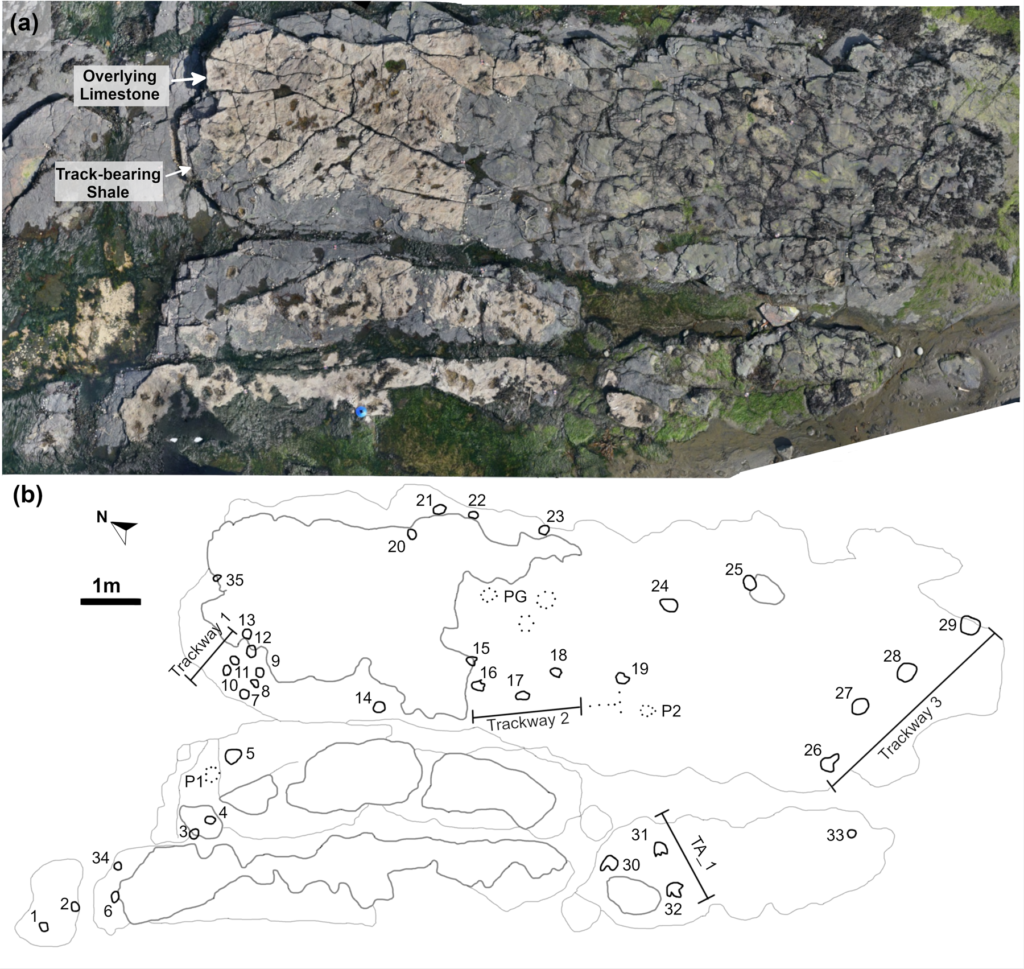@WFS,World Fossil Society,Riffin T Sajeev,Russel T Sajeev
Novel track morphotypes from new tracksites indicate increased Middle Jurassic dinosaur diversity on the Isle of Skye, Scotland
Citation: dePolo PE, Brusatte SL, Challands TJ, Foffa D, Wilkinson M, Clark NDL, et al. (2020) Novel track morphotypes from new tracksites indicate increased Middle Jurassic dinosaur diversity on the Isle of Skye, Scotland. PLoS ONE 15(3): e0229640. https://doi.org/10.1371/journal.pone.0229640

(a) The orthophoto for Brother’s Point Site 1 (BP1) strikingly demonstrates the high contrast between the dark gray, track-bearing shale and the overlying and in-filling light tan limestone in the Lonfearn Member of the Lealt Shale Formation. (b) The site map highlights the track distribution spatially and denotes the orientation and length of the trackways relative to one another. Each individual track is labeled with its field number (1–35). P1 and P2 denote ‘possible’ tracks 1 and 2 while PG denotes a ‘possible group’ of shallow impressions. Thick black lines denote the track outlines while lighter lines highlight the contrast between the lithologies and fractures on the outcrop. Dark gray lines delineate the extent of the limestone while lighter gray lines show the platform edges of the shale and some fractures within it. One quadrupedal trackway (Trackway 1; BP1_Twy_01), two bipedal trackways (Trackway 2–3; BP1_Twy_02 –BP1_Twy_03), and one set of associated tracks (TA_1) are present at the site.
Dinosaur fossils from the Middle Jurassic are rare globally, but the Isle of Skye (Scotland, UK) preserves a varied dinosaur record of abundant trace fossils and rare body fossils from this time. Here we describe two new tracksites from Rubha nam Brathairean (Brothers’ Point) near where the first dinosaur footprint in Scotland was found in the 1980s. These sites were formed in subaerially exposed mudstones of the Lealt Shale Formation of the Great Estuarine Group and record a dynamic, subtropical, coastal margin. These tracksites preserve a wide variety of dinosaur track types, including a novel morphotype for Skye: Deltapodus which has a probable stegosaur trackmaker. Additionally, a wide variety of tridactyl tracks shows evidence of multiple theropods of different sizes and possibly hints at the presence of large-bodied ornithopods. Overall, the new tracksites show the dinosaur fauna of Skye is more diverse than previously recognized and give insight into the early evolution of major dinosaur groups whose Middle Jurassic body fossil records are currently sparse.
@WFS,World Fossil Society,Riffin T Sajeev,Russel T Sajeev



 March 12th, 2020
March 12th, 2020  Riffin
Riffin  Posted in
Posted in  Tags:
Tags: 